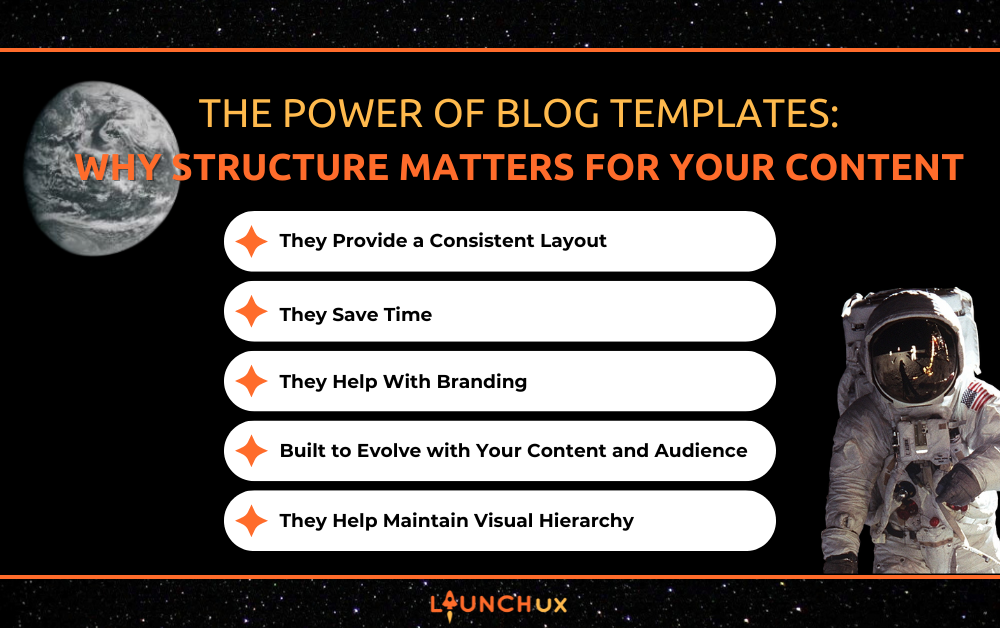At LaunchUX, we understand that publishing content consistently isn’t just about writing—it’s also about presentation. A clean, professional design may be the deciding factor between engaging readers or losing them entirely. That’s where the blog template becomes an essential part of your content strategy. Templates streamline your workflow, maintain brand consistency, and ensure your message is delivered clearly. Whether you’re a solo blogger or managing a whole content team, having a reliable structure makes the entire process more efficient. Let’s explore why blog templates are such a game-changer for modern digital content.
They Provide a Consistent Layout
Structure That Supports Readability
A well-designed blog template gives every post a familiar structure. This typically includes areas for the title, featured image, subheadings, body content, and author bio. When each post follows the same pattern, readers know what to expect and can navigate your content more easily. That consistency builds trust and makes your blog feel cohesive. Instead of guessing where to find information, users are guided smoothly through each article. Clear structure encourages them to stay longer and return more often.
Professional Appearance Across Posts
Using a blog template ensures that even if multiple people contribute to your blog, the visual style remains uniform. Fonts, spacing, image formatting, and color schemes all stay aligned with your brand. This not only improves aesthetic appeal but also reinforces credibility. Visitors associate consistency with professionalism, which increases the likelihood of them engaging further. A unified presentation enhances your site’s overall brand impression. First impressions matter, and a template ensures yours is always strong.
Reduces Design Errors
Manually formatting each post leaves room for mistakes like inconsistent font sizes, awkward spacing, or missing elements. A template prevents these issues by standardizing the layout. This means fewer errors, faster publishing, and better content quality overall. A blog that looks polished from post to post creates a positive user experience. The layout becomes something you no longer have to worry about. That frees you up to focus on creating valuable, engaging content.
They Save Time
Faster Publishing Process
A blog template streamlines the entire content workflow. Instead of building every post from scratch, writers and editors can plug content into a ready-made layout. This dramatically reduces formatting time and eliminates repetitive tasks. It’s beneficial for teams producing content on a tight schedule. When the format is already decided, more energy can be spent on refining the message. The result is faster turnaround and more consistent output.
More Focus on Content Quality
When you’re not distracted by design choices, you can focus more deeply on the content itself. A blog template removes the guesswork from layout and frees your mind to concentrate on storytelling, research, and clarity. Better writing naturally follows when the technical pieces are already in place. This focus on content can significantly improve the value your blog offers to readers. Over time, consistent quality builds authority and audience loyalty. A streamlined process means better posts, faster.
Great for Scaling Content
As your blog grows, so does the demand for efficiency. A template makes scaling your content operations much more manageable. Whether you’re publishing once a week or multiple times a day, templates help maintain quality at any volume. Even as your team expands, everyone can follow the same structure, ensuring consistency. The more scalable your system is, the more sustainable your content efforts become. Blog templates are an essential part of growing without sacrificing quality.
They Help With Branding
Visual Consistency Across Posts
Your blog is an extension of your brand, and visual consistency reinforces that identity. A well-designed blog template integrates your brand colors, typography, and logo into every post layout. This creates a seamless connection between your blog and the rest of your website. Readers begin to associate the look and feel of your posts with your business. That kind of recognition strengthens your brand’s presence online. Over time, visual consistency turns casual visitors into loyal followers.
Reinforcing Brand Voice and Tone
Templates don’t just affect how things look—they also influence how your content feels. A consistent layout can support the tone and rhythm of your brand voice. For example, a formal business blog might use structured subheadings and uniform paragraph lengths. In contrast, a lifestyle blog could use more playful formatting and visual breaks. Whatever your tone, the blog template helps express it consistently. This harmony between form and voice deepens audience connection.
Supporting Visual Branding Elements
Beyond fonts and colors, your blog template can house reusable visual elements like custom dividers, quote blocks, or CTA buttons. These features make your posts feel on-brand without needing to reinvent the wheel each time. You’re not just creating a post—you’re creating a branded experience. These details may seem small, but they add up to a more professional presentation. Over time, even your blog’s visual elements become recognizable. Branding isn’t just what you say—it’s how you show up.
Built to Evolve with Your Content and Audience
Flexible Design Options
No two blogs are precisely alike, and your blog template shouldn’t be one-size-fits-all. Modern templates are designed to be adaptable, letting you tailor layouts to suit your content strategy. You can move sections, swap out widgets, or adjust styling as your needs evolve. This means your blog stays fresh without needing a complete redesign. Flexibility makes templates a long-term solution, not just a temporary fix. Your content may change—but your structure can evolve with it.
Easy Plugin and Tool Integration
Today’s blog templates often come ready to integrate with tools like SEO plugins, social sharing buttons, and comment systems. This allows you to extend functionality without breaking the design. You can optimize posts for search engines, encourage sharing, or track performance—all within the template. It saves time while giving you more power over your content’s reach. A good template doesn’t limit you; it empowers you to grow—the right tools plus the proper layout equal long-term success.
Scalable and Future-Proof
As your blog expands, your needs will change. Templates that can scale with your goals help you avoid future headaches. You might start with a basic layout and eventually add features like category pages, author bios, or embedded videos. A flexible template grows with your brand instead of holding it back. With customization, your blog can reflect your evolution without losing consistency. It’s a wise investment in both your present and your future.
They Help Maintain Visual Hierarchy
Clear Information Flow
A well-structured blog template organizes content in a way that’s easy to follow. Proper use of headers, paragraph spacing, and section dividers guides the reader’s eye naturally through the post. This hierarchy helps users scan quickly and decide what to read. It’s essential for mobile readers who rely on visual flow to stay engaged. When information is organized clearly, it’s more likely to be retained. The layout becomes a silent partner in effective communication.
Emphasis Where It Matters
Templates help highlight key points through bold text, quotes, bullet sections, or images. This visual emphasis ensures readers don’t miss the most important takeaways. When used correctly, hierarchy leads the user from curiosity to clarity without overwhelming them. The reader doesn’t have to work hard to understand your message. These visual cues are subtle but powerful. They make reading effortless and intuitive.
Supports Better Accessibility
Maintaining a clear visual hierarchy isn’t just good design—it also supports accessibility. Screen readers rely on heading tags and logical layout to interpret content. A thoughtful blog template ensures your posts are designed to accommodate diverse user needs, including accessibility considerations. Accessibility enhances user experience and can also support SEO performance. When your content is easy to access and understand, more people can engage with it. That inclusivity strengthens your reach and reputation.
Conclusion
A well-designed blog template does far more than make your posts look good. It saves time, supports branding, improves readability, and scales effortlessly with your content needs. At LaunchUX, we build websites and content systems that combine great design with smart strategy—because we know a blog is only as effective as its structure. Whether you’re starting from scratch or looking to improve your current setup, using a strong template can elevate your entire content operation. With the right tools in place, your attention can stay where it’s most impactful: engaging and serving your audience.
Ready to build a better blog? Let LaunchUX help you find or create the perfect blog template—contact us today.





